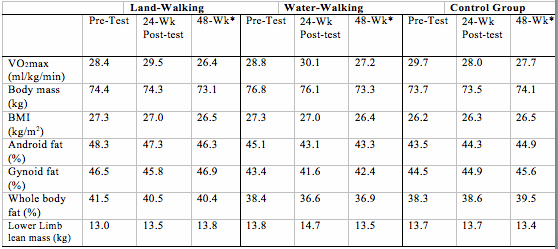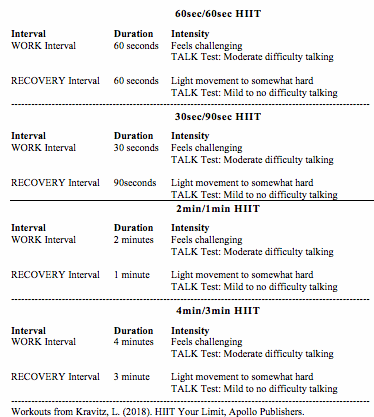Water Workouts Make a Splash
By Len Kravitz, PhD
Studies Reviewed
Haynes, A. Naylor, A., Carter, H.H., et al. (2020). Land-walking vs. water-walking interventions in older adults: Effects on aerobic fitness, Journal of Sport and Health Science (2020),
https://doi.org/10.1016/j.jshs.2019.11.005
Naylor, L.H., Maslen, B.A., Cox, K.L., et al. (2020). Land- versus water-walking interventions in older adults: Effects on body composition. Journal of Science and Medicine in Sport, 23, 164-170.
Introduction
It is very well established that low cardiorespiratory fitness is an independent predictor for cardiovascular disease and all causes of mortality (Haynes et al., 2020). Haynes and colleagues cite research indicating that a one met (i.e., 3.5 ml/kg/min) improvement in aerobic capacity has been shown to result in a 15% decrease in mortality from cardiovascular disease. However, with certain populations, such as older women and men, performing regular land exercise to improve aerobic capacity may need to be adjusted to avoid musculoskeletal injury. Haynes et al. propose that an optimal exercise recommendation in older adults needs to focus on maximizing the benefits while minimizing the risks.
Enter water-based workout programs. Water-based exercise programs have often been employed with older populations, and those with elevated injury risk, because of the decreased gravitational forces and impact on the skeletal system. However there is very little long term data on the cardiorespiratory and body composition effects comparing water-walking to land-walking (at the same relative intensity). In ONE study, divided up into two publications, researchers from Australia investigated these questions.
Study Prospectus:
This study recruited men and women (&Mac179; 50 years of age) volunteers for a 6-month intervention of water-walking, land-walking or a control group. Maximal aerobic capacity and body composition change were the main outcome variables tested at the beginning and after a 24-week intervention. The authors hypothesized that the water-walking and land-walking would improve aerobic fitness and body composition similarly, and be better than the non-active control group.
Overall Thesis of Study:
With water-walking, the lower limbs are working against the resistance of water. Importantly, balance and fall prevention are often a concern with exercising men and women as they age. The water environment minimizes the risk of falls and possible joint injury. Therefore, if water-walking is as efficacious as land-walking for health, then it is a safe option for many older participants, and those at risk to falls, to consider.
Participants:
Inclusion criteria for the 72 male and female participants (average age = 62 yrs) were that they were &Mac179; 50 yrs old, relatively inactive (< 60 minutes of purposeful physical activity per week), non-smokers (for at least > 12 months prior to the study), alcohol intake less than 280 grams per week, and no injuries, illnesses or disease (i.e., cardiovascular disease, diabetes, stroke or heart attack) that would forbid study participation. The females in the study were all postmenopausal. Men and women meeting the criteria above underwent a university physical exam to meet other target criteria including a body mass index < 40 kg/m2, resting blood pressure with < 160 mmHg systolic and < 100 mmHg diastolic, fasting blood cholesterol < 7 mmol/L, and urea and creatinine levels that ruled out the presence of abnormal kidney function.
Exercise Intervention
There were 3 supervised exercise sessions per week for the water-walking and land-walking. Participants were randomly assigned to the water-walking, land-walking or inactive control groups. The water-walking took place in chest-deep (reaching xiphoid process) water at a university pool (20 meters wide x 30 meters length) heated to 28-30 degrees Celsius (i.e., 82-86 degrees Fahrenheit). The land-walking took place on flat paved and grass terrain outdoors, in and around the university grounds. Exercise intensity, based from the VO2max pretest was initially set at 15 minutes at 40-45% of heart rate reserve (HRR), which progressed to 50 minutes at 55-65% HRR over the course of the study. Session 2 of each week was an interval workout with one-minute work intervals at the specified intensity for that week alternating with 30 seconds rest. Over the course of the 24 weeks the interval workout changed to a 2-minute work intervals (at the week's specified intensity) alternating with a 2-minute recovery. Heart rates were monitored continuously and recorded by the trainers every 5 minutes. In order to match the intensities of the water-walking and land-walking, walking speed was adjusted. All sessions included a light aerobic dynamic range of motion warm-up and concluded with a cool-down. The participants who were randomly assigned to the control group were instructed not to change their pre-study physical activity for the length of the study.
Testing
A graded maximal effort treadmill test, in 3-minute increments, with 12-lead ECG monitoring was used to asses maximal aerobic capacity at the start and after the 24 week intervention. Waist and hip measurements were taken to determine the BMI (weight in kilograms divided by the square of height in meters) measurements. Dual X-ray absorptiometry (DXA) was used to determine body segment and whole-body fat and lean tissue values, as well as android (i.e., abdominal) and gynoid (i.e., hip) regional fat areas.
Results and Discussion
Of the 72 original participants, only one participant withdrew from the study in this 6-month study and thus data analysis was conducted on 71 volunteers. One interesting EXTRA measure the researchers did was to collect post-study data on the main variables at 48 weeks as well. Between week 24 and week 48 participants had no required contact with the researchers. Participants were free to exercise or not exercise, of their own choice. Data of the main outcome variables is displayed in Table 1 (showing Pre-test, 24-week post-test and 48-week option exercise periods)
Table 1. Aerobic Performance and Body Composition Results of Land-Walking, Water Walking and Control Groups
|
 |
Data adapted from Haynes et al. 2020 and Naylor et al. 2020
*Between the 24-Week Post-Test and 48-Week assessment the participants were exercising on their own free will. There were no official interactions with the researchers during that period.
The VO2max values significantly increased in the land-walking and water-walking groups as compared to the control group. However, the land-walking and water-walking groups equally improved maximal aerobic capacity. A critical body composition significant difference was seen in android fat %. With android fat the land-walking and water-walking improved significantly (and equally) as compared to the control. Android adiposity, also called visceral fat, is characterized by intra-abdominal fat. This fat pattern is associated with increased risk of cardiovascular disease, hyperlipidemia, hypertension, type 2 diabetes and insulin resistance (Okosun, Seale, Lyn, 2015). No other differences in body mass, BMI or body fat were observed. Interestingly, the water-walking group showed a significant improvement in lower limb lean mass (i.e., muscle) as compared to the control group. This was not observed with comparisons of the land-walking group to the control group. Haynes et al. (2020) propose that water-walking exercise may be a form of combined aerobic and resistance exercise.
Take-Homes Messages
In perhaps the longest, most well-designed training study ever conducted with water-walking, the cardiorespiratory and body composition results are equally beneficial to land-walking at the same intensity. Importantly, both groups progressed to moderate intensity steady state and interval training workouts during the 6-month study. The water-walking and land-walking had a significant (and POSITIVE) decrease in visceral fat, the fat pattern associated with major diseases (i.e., cardiovascular disease, hyperlipidemia, hypertension, type 2 diabetes and insulin resistance). Naylor et al. 2020 highlight that aging is associated with a decrease in muscle mass and increase in fat mass. However, with water-walking there was an increase in lower limb muscle mass and decrease in the abdominal body fat. The use of the dual energy X-ray absorptiometry proved most beneficial for this study in determining precisely where body composition changes were taking place. The 48-week data, where participant self-selected whether they wished to continue the exercise program on their own indicates that exercise compliance may have been dipping. In many ways the implications denote how important fitness pros can be in motivating older clients to maintain their exercise programs.
Side Bar 1: Four Water-Walking and Land-Walking HIIT Workouts
In addition to the two HIIT workouts described in this research, here are 4 additional walking HIIT workouts. The title of each HIIT workout indicates its WORK/RECOVERY ratio in seconds or minutes. Fitness pros should design the length of the workout appropriate to the client's fitness level and health. Subjective intensity monitoring is shown. Make sure there is a warm-up and cool-down |
 |
|
|
 |
Bio:
Len Kravitz, PhD, CSCS, is the program coordinator of exercise science at the University of New Mexico, where he received the Outstanding Teacher of the Year and Presidential Award of Distinction. His third book is HIIT Your Limit: High-Intensity Interval Training (Amazon).
|
|
|
|